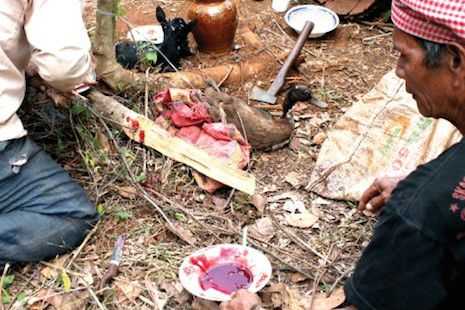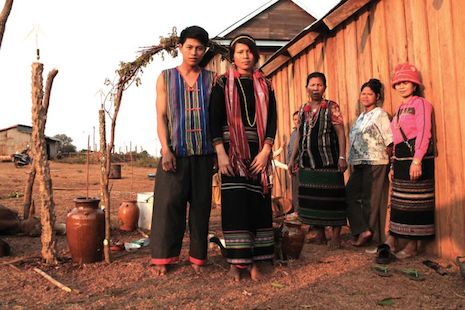
Traditionally, ethnic Bunong weddings take three days and involve the sacrifice of up to 200 animals (Photo supplied)
An ancient ethnic minority tradition is at risk of disappearing from rural Cambodia, as the Bunong people increasingly incorporate Khmer traditions into their wedding ceremonies.
About a third of Bunong weddings now feature the typical trappings of their Khmer counterparts – from sending invitations to proposing with material objects like soap or perfume, to playing music and dancing – according to the Mondulkiri Resources and Documentation Centre (MRDC).
“It is a good way to get some money and gifts from participants who are invited to the wedding ceremony,” said Chey Bunthy, project manager at MRDC, via email. “Thus they can use that money to support the expenditure in their wedding ceremony. In Bunong traditional way it is not required or expected for guests to give money.”
Traditionally, Bunong weddings take three days and involve the sacrifice of up to 200 animals. It is said that if Bunong weddings traditions are not meticulously followed, they will cause illness or death in the village.
“During my wedding, I, my family and my relatives went to Chak Ya’s house with 30 animals such as pigs, dogs, cows, buffaloes, goats and some fruits,” said Jonh Baran, a farmer from Pu Tang village in Mondulkiri province, who got married in July in a Bunong-Khmer wedding.
"The first day was a sacrifice ceremony, praying in the forest near the edge of the lake in the community and later sharing the meat of the animal with the groom and bride’s relatives.”

If a couple do not perform the necessary rituals during their wedding, and a villager later falls ill or dies, the couple will be deemed responsible and have to pay compensation (Photo supplied)
The other type of weddings, Katis weddings, unite couples who are not approved of by their elders, typically the marriage of relatives or the offspring of people believed to be sorcerers, and those involve extra steps, including the sacrifice of additional animals and prayer.
If a couple do not follow the correct steps and a villager later falls ill or dies, they will be deemed responsible and have to pay compensation, this may include the payment of animals (especially buffaloes) or slavery for 10 to 20 years, according to the MDRC.
While it depends on the economic status of the family as to how many animals are sacrificed, people tend to sacrifice more as this brings better luck for them.
“After the animal is sacrificed, the blood of those animals is placed on the heads of the relatives or people who joined the wedding ceremony to bring good luck and cure sickness,” Baran said.
“We always respected our tradition because we believed that if we didn’t do it, it will give us bad luck in life and everyone will be at risk.”
The couple officially becomes wed after a ceremony in which the couple are cloaked under a scarf and required to drink a jar of wine – without spilling or regurgitating it. In some villages, it is then a race to lift the scarf up, for the partner who does so first is considered the dominant partner and cannot be argued with.
During the sacrificing and scarf ceremonies, the villagers dance to traditional Bunong music, notifying the ancestors that the couple is married. The celebration continues into the night with rice wine being donated and consumed by relatives as they dance to the beat of the gong.
“The main danger that is facing the traditional Bunong wedding ceremony is people moving away from it due to it not being clear on the stages and practices that comprise it,” Bunthy said.
She said that already some parts of traditional clothes, like breech cloth and Bunong sarongs have ceased to exist as the knowledge of how to produce them has not been handed down through the generations.
Full story: A people’s disappearing wedding traditions
Source:The Phnom Penh Post


